Living in a small space can be challenging, but it also has its advantages. Small spaces are easier to decorate, keep clean, and organize, making them advantageous for homeowners. With a few simple fixes like clearing clutter, adding reflective surfaces, and choosing neutral colors, you can make a room look bigger without breaking the bank. In this article, we will explore DIY hacks to make your small space feel larger, including small space hacks and DIY small space tips.
By applying these DIY small space tips, you can create a more spacious and comfortable living area. From using mirrors to create an illusion of depth to choosing a light color palette, we will cover it all. Our goal is to provide you with practical and cost-effective solutions to make your small space feel larger and more inviting.
Key Takeaways
- Small spaces are easier to decorate, keep clean, and organize.
- Clearing clutter and adding reflective surfaces can make a room look bigger.
- Choosing neutral colors and light color palettes can create an illusion of more space.
- Using mirrors and transparent materials can help create an open feeling in a room.
- Applying these DIY hacks can make your small space feel larger and more comfortable.
Understand the Importance of Space Perception
Your perception of space greatly influences how you feel and function in your apartment. Cramped and dark rooms can lower your mood, while light and bright areas can uplift your spirits. Understanding space perception is key to creating a home that feels both comfortable and efficient.

What is Space Perception?
Space perception refers to how you visually and psychologically interpret your living area. Experts like Ann Marie Cousins highlight the importance of storage solutions in keeping spaces uncluttered. Irene Gunter suggests using wall-hung or slim-leg furniture in small bathrooms to enhance the feeling of space.
How It Affects Your Mood and Functionality
A well-perceived space can boost your mood and improve daily functionality. Justyna Korzynska recommends painting skirting boards the same color as walls to create an illusion of larger spaces. Additionally, Abbie Ireland emphasizes the use of mirrors to bounce light around, making rooms appear more expansive. By implementing thoughtful apartment organization ideas, you can maximize small spaces effectively, leading to a more enjoyable living environment.
Use Mirrors to Create Illusion of Depth
Mirrors are a powerful tool in space-saving solutions, making rooms appear larger and more open. By reflecting light and creating visual continuity, mirrors can transform tight spaces into airy, expansive areas.
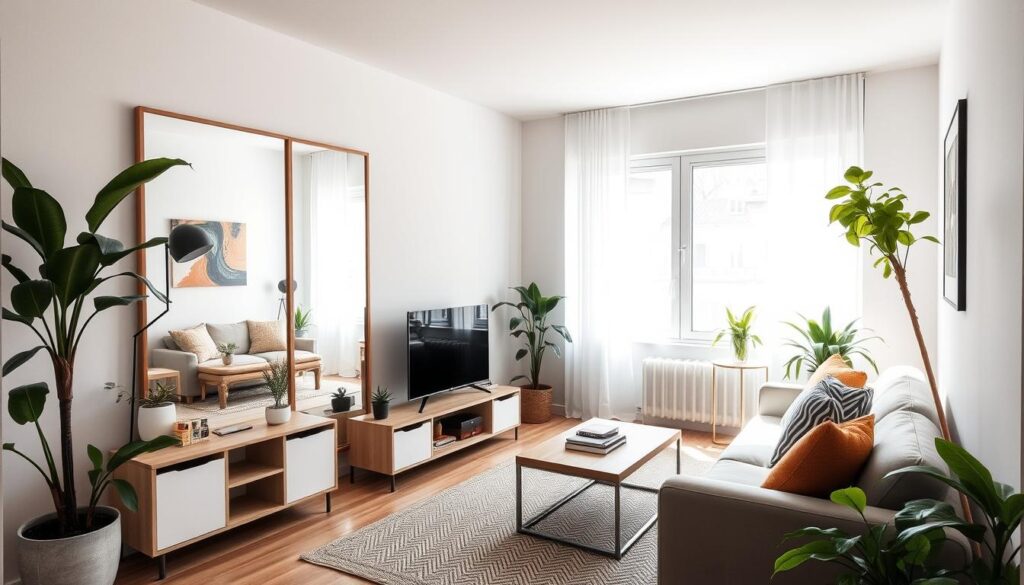
Types of Mirrors to Consider
Choosing the right mirror is essential for maximizing space. Consider the following options:
- Full-Wall Mirrors: Covering an entire wall, these mirrors create a striking visual impact and significantly enhance the perception of space.
- Mirrored Furniture: Tables, cabinets, and shelves with mirrored surfaces can bounce light around the room, contributing to a more spacious feel.
- Mirrored Backsplashes: In kitchens, mirrored splashbacks reflect the culinary area, making it seem more extensive and bright.
Strategic Placement Tips
Proper placement of mirrors enhances their effectiveness in creative space-saving techniques. Here are some tips:
- Opposite Windows: Positioning a large mirror directly across from a window reflects natural light, amplifying brightness and the sense of openness.
- Narrow Hallways: Placing mirrors at the end of hallways creates an illusion of depth, making the space appear longer and less confined.
- Corner Placement: Adding mirrors to corners without natural light sources can brighten these areas, making the entire room feel more inviting.
| Mirror Type | Benefits |
|---|---|
| Full-Wall Mirrors | Creates a bold statement and expands visual space |
| Mirrored Furniture | Bounces light around, enhancing brightness and depth |
| Mirrored Backsplashes | Reflects kitchen space, making it appear larger |
| Mirrored Closet Doors | Instantly doubles the visual size of the room |
Choose a Light Color Palette
Selecting the right color palette is essential in making your small space appear larger and more inviting. Light colors can transform a cramped area into an open and airy environment, enhancing your small space decorating ideas.
Best Paint Colors for Small Spaces
- Soft Blue: Creates a calming effect and adds a sense of depth.
- Light Green: Brings a touch of nature indoors, making the room feel fresh.
- Warm White: Reflects light effectively, making the space brighter.
- Pale Gray: Offers a modern look while keeping the room light and spacious.
How Color Affects Room Brightness
The colors you choose significantly influence the brightness and overall feel of your room. Light and cool tones can enhance natural light, making your space look larger and more organized. Incorporating these hues into your walls, furniture, and decor can optimize your room organization tricks, ensuring a harmonious and expansive atmosphere.
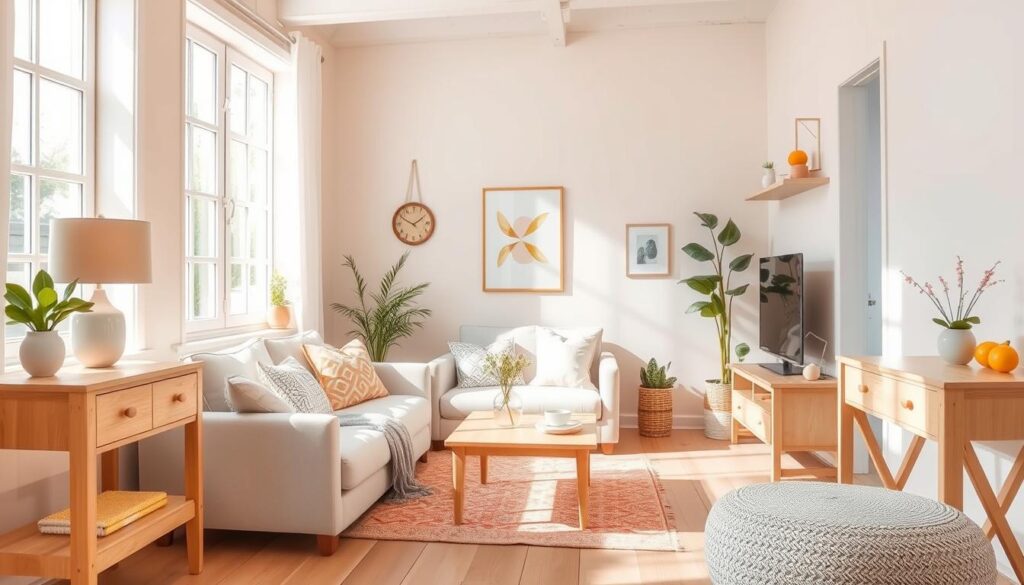
| Color | Effect on Space | Best Use |
|---|---|---|
| Soft Blue | Expands visual depth | Walls and accents |
| Light Green | Freshens up the room | Furniture and decor items |
| Warm White | Maximizes light reflection | Ceilings and larger surfaces |
| Pale Gray | Modern and spacious feel | Wall paint and upholstery |
Optimize Furniture Arrangement
Arranging your furniture thoughtfully can make a big difference in how spacious your room feels. By following some simple small space hacks, you can maximize small space effectively.
Guidelines for Arranging Furniture
Start by moving furniture away from walkways to create open pathways. Choose low-profile pieces that don’t dominate the room. Position large, tall furniture against walls to free up central space. Avoid blocking windows and doors to enhance the flow of light and movement.
Creating Conversation Zones
Define areas for different activities without overcrowding. Use rugs or lighting to separate spaces visually. Arrange seating to face each other, encouraging interaction while maintaining a clear layout. This approach helps in maximizing small space by creating functional areas without clutter.

| Small Space Hacks | Benefits |
|---|---|
| Use multi-functional furniture | Reduces clutter and saves space |
| Arrange furniture in clusters | Creates defined areas without taking up extra space |
| Utilize vertical storage | Makes the room look taller and more organized |
| Keep pathways clear | Enhances the flow and openness of the room |
| Choose light-colored furniture | Reflects light, making the space appear larger |
Incorporate Multi-Functional Furniture
Maximize your living space with multi-functional furniture that blends style and practicality. These pieces offer space-saving solutions while enhancing your apartment’s organization.
Examples of Dual-Purpose Items
- Sofa with Pullout Storage: Save Space Furniture offers sofas that include hidden compartments for extra storage.
- Storage Ottomans: Canada-based Save Space Furniture provides ottomans that open up to store blankets or other items.
- Murphy Beds: Murphy Bed NYC creates beds that fold into wall units, freeing up floor space during the day.
- Expandable Desks: Resource Furniture offers desks that transform into dining tables, perfect for small apartments.
How to Maximize Utility
Select pieces that match your lifestyle and space needs. Choose furniture with visible legs to enhance the perception of space. Opt for neutral colors to keep the area feeling open and airy. Position multi-functional items strategically to ensure easy access and maintain a clutter-free environment.

| Item | Function | Brand |
|---|---|---|
| Sofa with Storage | Seating and hidden storage | Save Space Furniture |
| Storage Ottoman | Footrest and storage | Save Space Furniture |
| Murphy Bed | Bed and wall unit | Murphy Bed NYC |
| Expandable Desk | Desk and dining table | Resource Furniture |
Utilize Vertical Space Effectively
Maximizing your vertical space can instantly make your small area feel more open and organized. By focusing upwards, you create an illusion of height and add functionality without sacrificing floor space.
Wall-Mounted Shelves and Solutions
Implementing creative space-saving techniques like wall-mounted shelves can transform your storage approach. Floating shelves provide a minimalist look, while vertical garden systems introduce greenery without cluttering surfaces.
- Floating Shelves: Ideal for displaying decor or storing books without taking up floor space.
- Vertical Garden Systems: Perfect for adding a touch of nature in kitchens or living rooms.
- Hanging organizers: Utilize back-of-door spaces for additional storage.
Tall Furniture Styles to Consider
Choosing tall furniture is another effective DIY small space tip. Items like floor-to-ceiling bookcases not only provide ample storage but also draw the eye upward, enhancing the room’s perceived height.
- Vertical Bookcases: Maximize storage without occupying much floor area.
- Vertical Room Dividers: Create distinct areas in open-plan spaces while maintaining an airy feel.
- High-Standing Desks: Offer workspace without compromising on legroom.
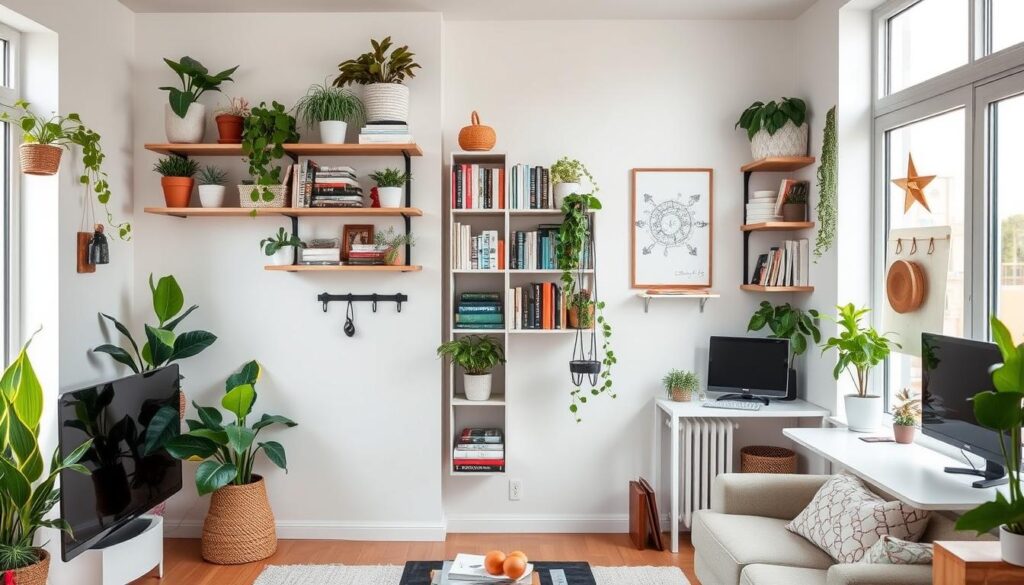
| Solution | Benefits | Examples |
|---|---|---|
| Floating Shelves | Minimalist design, frees up floor space | IKEA Lack Shelf, Wallniture Floating Shelf |
| Vertical Garden Systems | Adds greenery without clutter, improves air quality | Living Wall Pots, Vertical Plant Towers |
| Floor-to-Ceiling Bookcases | Maximizes storage, enhances room height | Wayfair Vertical Bookcase, CB2 Tall Shelving |
Keep Clutter to a Minimum
Keeping clutter under control can make your small space feel larger and more inviting. Here are some room organization tricks and apartment organization ideas you can use today:
Easy Organization Hacks
- One In, One Out: For every new item you bring into your home, remove one item to keep possessions in check.
- KonMari Method: Sort your belongings by category and keep only those that spark joy.
- Smart Storage Solutions: Utilize under-bed storage, multi-functional furniture, and wall-mounted shelves to save space.
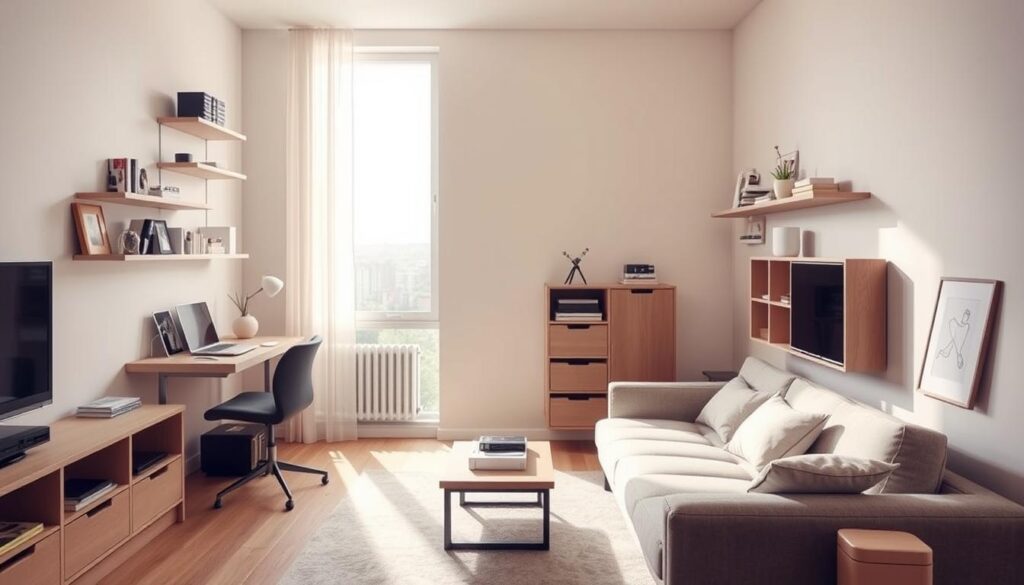
Benefits of a Minimalist Approach
Embracing minimalism brings several advantages to your living space:
- Improved Visual Clarity: A clutter-free environment appears larger and more open.
- Easier Maintenance: Fewer items mean less time spent cleaning and organizing.
- Reduced Stress: A tidy space promotes a sense of calm and well-being.
| Organization Hack | Benefit |
|---|---|
| One In, One Out | Maintains balance and prevents accumulation of unnecessary items. |
| KonMari Method | Ensures you keep only items that truly matter to you. |
| Smart Storage Solutions | Maximizes space usage and keeps items out of sight. |
Let Natural Light In
Embracing natural light can significantly maximize small space and enhance your living environment. A well-lit room appears larger, more inviting, and energy-efficient.
Benefits of Natural Lighting
- Creates an open and airy feel
- Improves mood and well-being
- Reduces reliance on artificial lighting
- Highlights your small space decorating ideas
Tips to Maximize Window Exposure
- Use sheer curtains to allow more light in
- Keep windows clean and unobstructed
- Incorporate mirrors to reflect light and create depth
- Opt for sliding or foldable glass doors to enhance space perception
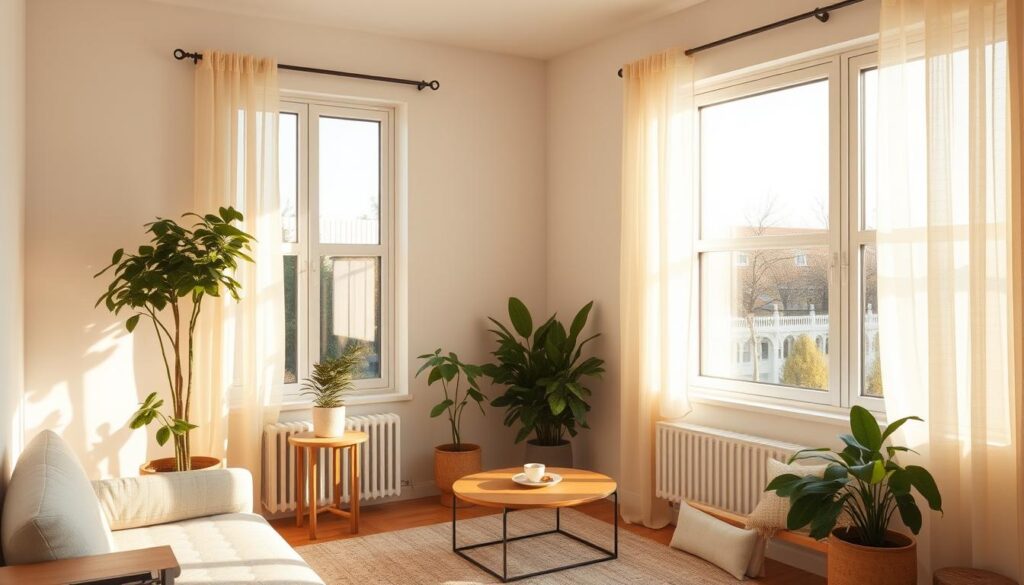
| Tip | Benefit |
|---|---|
| Use Sheer Curtains | Allows maximum natural light to enter |
| Strategic Mirror Placement | Reflects light and creates a sense of depth |
| Keep Windows Clean | Ensures unobstructed light flow |
| Sliding Glass Doors | Enhances the visual size of the room |
Add Layered Lighting Techniques
Enhancing your small space doesn’t stop with furniture arrangement. Effective lighting plays a critical role in making your area appear larger and more inviting. Implementing DIY small space tips with creative lighting solutions can transform your room’s ambiance.
Types of Lighting to Use
There are three main types of lighting to consider:
- Ambient Lighting: Provides overall illumination using ceiling lights or recessed lighting fixtures.
- Task Lighting: Focuses on specific areas for activities like reading or cooking, using items like wall-mounted lights or under-cabinet LEDs.
- Accent Lighting: Highlights decorative elements or architectural features with spotlights or decorative lamps.
How to Layer for Effect
Combining these lighting types creates depth and dimension. Start with ambient lighting as your base, then add task lighting where needed, and finish with accent lighting to draw attention to key areas. Utilizing creative space-saving techniques such as wall sconces or LED strip lights can maximize light without occupying floor or table space.
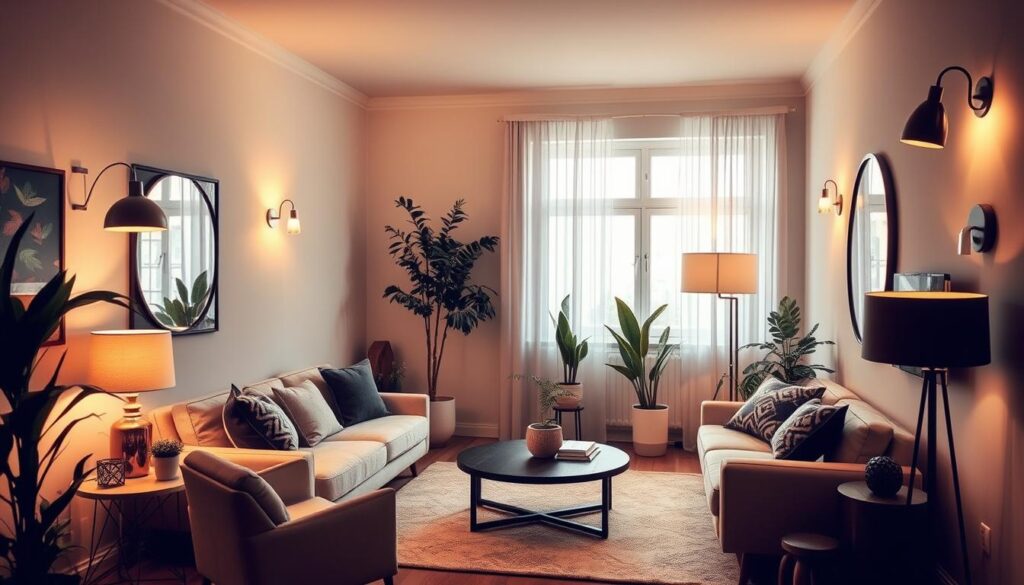
| Lighting Type | Examples | Purpose |
|---|---|---|
| Ambient | Ceiling fixtures, recessed lights | Overall illumination |
| Task | Under-cabinet LEDs, desk lamps | Focused activities |
| Accent | Spotlights, decorative lamps | Highlighting features |
Use Rugs to Define Areas
Rugs are essential for small space decorating ideas, helping you maximize small space without creating physical barriers. By choosing the right rug, you can visually separate different zones within a room, enhancing both functionality and aesthetics.
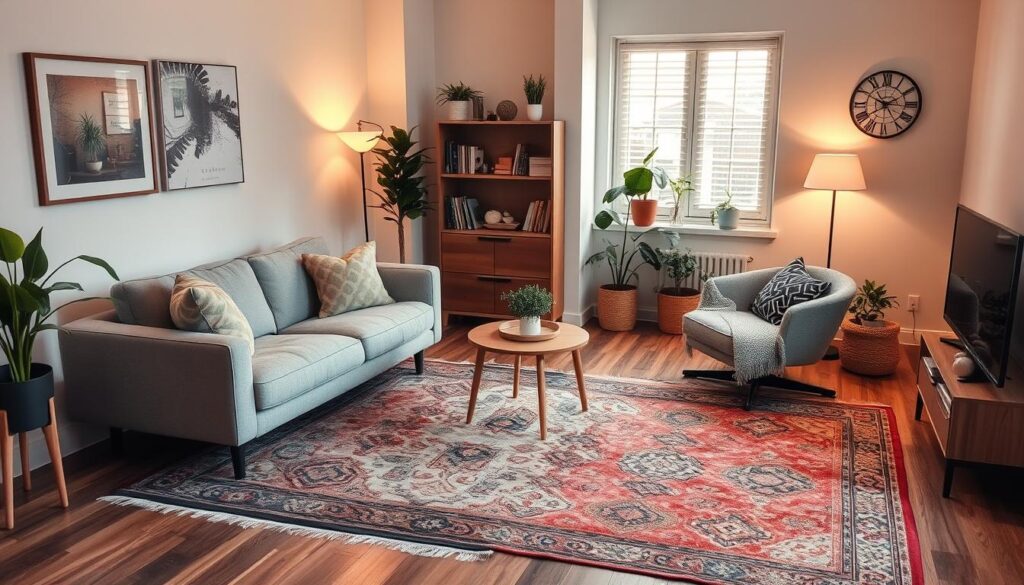
Choosing the Right Size and Style
Selecting the appropriate rug size is crucial. For living rooms, an 8×10 or 9×12 rug works best, ensuring it anchors furniture without overwhelming the space. In smaller areas like bedrooms or kitchens, a 4×6 rug provides a cozy touch without taking up too much room.
Opt for light-colored rugs to create the illusion of a larger area. Cristina recommends sticking to light, cool tones that complement your wall paint. Striped rugs, especially with stripes perpendicular to the room’s long walls, can make the space appear wider.
Layout Ideas for Rugs in Small Spaces
Strategic rug placement can define different areas effectively. Consider layering a small favorite rug over a larger, inexpensive sisal rug to add depth without clutter. For narrow spaces, runners are ideal for adding style and functionality.
In living rooms, ensure the rug is large enough to fit at least the front legs of your sofa. For bedrooms, place a rug beside the bed for a balanced look. Sarah suggests using cool-toned rugs in living rooms and bedrooms to trick the eye into perceiving more space.
| Rug Size | Recommended Areas | Style Suggestions |
|---|---|---|
| 4×6 | Next to bed, kitchen, entrance | Solid or monochromatic, light hues |
| 6×9 | Small living rooms with sofa against a wall | Cowhide rugs for unique shapes |
| 8×10 | Living rooms | Striped or large-scale neutral patterns |
| 9×12 | Spacious living areas | Light shag rugs for texture |
Create Focal Points Strategically
Creating focal points in your home can make small spaces feel more organized and intentional. By selecting a striking piece of furniture or a unique accessory, you draw attention and add character without overwhelming the room.
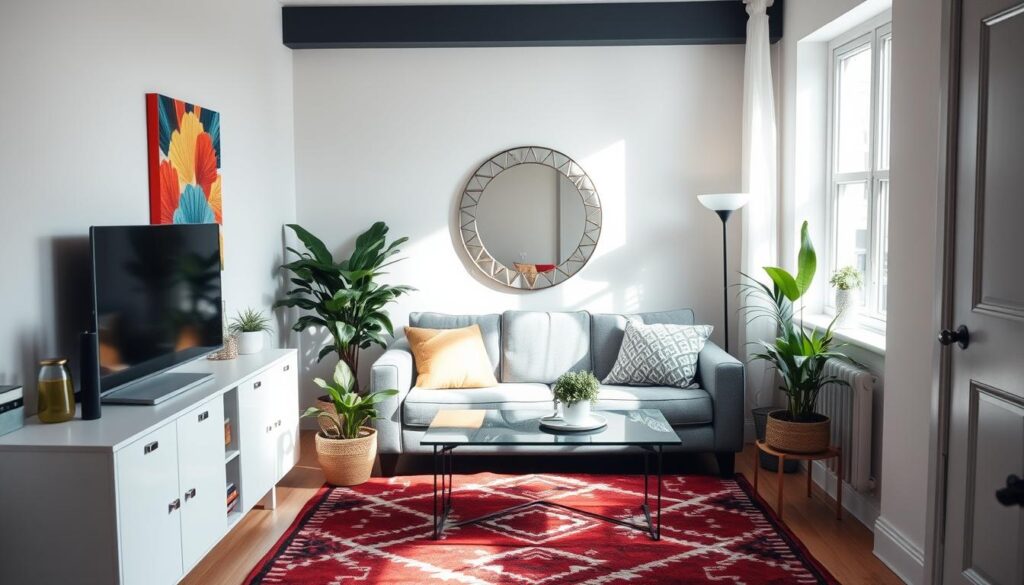
What Makes a Good Focal Point?
A good focal point should be eye-catching and serve a functional purpose. It can be a bold piece of art, a stylish bookshelf, or a distinctive piece of furniture. According to a Statista survey, nearly 60% of urban homeowners prioritize such elements to maximize their space.
Ideas for Eye-Catching Displays
Here are some creative space-saving techniques to create effective focal points:
- Large Artwork: A big painting or print can anchor the room and draw the eye.
- Unique Furniture: A mid-century modern chair or a sleek bookshelf can serve as a statement piece.
- Mirrors: Strategically placed mirrors reflect light and create the illusion of more space.
- Accent Walls: Use a different color or wallpaper on one wall to make it stand out.
Strategic placement of these elements ensures that they enhance the room’s perception and functionality.
| Focal Point | Benefits |
|---|---|
| Large Artwork | Draws attention and adds personality |
| Unique Furniture | Provides functionality and serves as decor |
| Mirrors | Reflects light and creates a sense of depth |
| Accent Walls | Adds visual interest and defines space |
Personalize with Decor, but Keep it Simple
Adding personal touches to your home is essential for creating a space that feels uniquely yours. However, in small areas, it’s important to strike the right balance to avoid clutter and maintain a sense of openness.
Balancing Personal Touches and Space
Too many decorative items can make a small space feel cramped. Instead, choose a few favorite ornaments or pieces that truly reflect your personality. For example, Carolyn Cerminara suggests using mirrors to display meaningful artwork without overcrowding surfaces. By selecting key pieces, you ensure that each item has a purpose and contributes to the room’s overall aesthetic.
Choosing Meaningful Decor Elements
Select decor items that hold special significance or add functionality to your space. Darrell Gardner from Cort recommends arranging framed artwork on a dedicated shelf to showcase your preferences without overwhelming the area. Additionally, utilizing multi-functional decor, such as stylish storage boxes, can help keep your apartment organized while adding a personal flair. By being intentional with your choices, you can enhance your home’s character while maintaining a clean and spacious environment.
FAQ
What are some effective small space hacks to make my apartment feel larger?
Implementing space-saving solutions like multi-functional furniture, utilizing vertical storage, and strategic mirror placement can dramatically expand the visual space in your apartment.
How can DIY small space tips help in organizing my living area?
A: DIY small space tips, such as creating custom shelving or repurposing furniture, allow you to maximize small space by making every inch of your living area both functional and stylish.
What are the best color palettes for small spaces?
Light and cool tones, such as soft whites, light grays, and pastel blues, are ideal for small space decorating ideas as they reflect more light and create an airy, spacious feel.
How can I use mirrors to enhance the perception of space?
Strategically placing mirrors opposite windows or in narrow hallways can reflect natural light and create the illusion of depth, making your space appear larger through effective creative space-saving techniques.
What are some creative space-saving techniques for small apartments?
A: Creative space-saving techniques include using wall-mounted storage, incorporating dual-purpose furniture like storage ottomans, and layering rugs to define areas without taking up floor space.
How can I declutter my small space effectively?
Adopting a minimalist approach and utilizing room organization tricks like the “one in, one out” rule or the KonMari method can significantly reduce clutter and enhance the sense of spaciousness.
What lighting options are best for small spaces?
Utilizing layered lighting techniques with ambient, task, and accent lighting, such as wall sconces and recessed lights, can add depth and make your space feel more open.
How do multi-functional furniture pieces benefit small living areas?
A: Multi-functional furniture, like murphy beds and shelving units with built-in storage, help maximize small spaces by serving multiple purposes and reducing the need for additional pieces.
What are some apartment organization ideas to maximize small space?
Implementing vertical storage solutions, using multi-functional furniture, and arranging furniture to create open pathways are effective apartment organization ideas to maximize small space.
How can rugs be used to define areas in a small space?
Strategically placed rugs can create the illusion of separate functional zones, such as dining or lounging areas, without the need for physical dividers, enhancing both organization and visual spaciousness through smart small space decorating ideas.
Source Links
- 11 Easy Ways to Make a Small Room Look Bigger
- 15 Ideas to Make a Small Room Look Bigger
- How to make a tiny apartment feel bigger – 14 expert tips to make the most of your small space
- 5 Things That Make Your Living Room Look Small—and How to Fix Them
- Maximize Space: Colors and Techniques to Make Your Compact Room Feel Spacious – Neon Trends Blog
- 10 Creative Ways to Use Mirrors in Small Spaces
- 10 Genius Ways to Use Mirrors in a Small Living Room ~ Fresh Design Blog
- Small Spaces, Big Ideas: Top 10 Design Hacks
- 15 Ideas to Make a Small Room Look Bigger
- 12 Lighting for Small Spaces to Make Them Feel Larger
- 15 Small Living Room Layout Ideas That Maximize Space
- 10 Ways to Make a Small Room Look Larger
- 15 Ideas to Make a Small Room Look Bigger
- 15 Transforming Furniture Solutions for Small Spaces
- Making a Small House Feel Bigger: Tips for Staging and Decorating
- 9 Ways To Make a Small Space Feel Bigger
- Minimalist design tips: How to make a small space look bigger – The Lifestyle Files
- How to Make a Small Room Look Bigger | Build Beautiful
- How to Make A Small Living Room Feel Larger and Spacious
- 7 Small Space Hacks to Make your Apartment Look and Feel Bigger
- 10 Design Tips and Ideas That Make Small Spaces Feel Bigger
- 12 Lighting for Small Spaces to Make Them Feel Larger
- Tricks to Make Your Apartment Larger with Lighting
- How to make a small room look bigger with lighting – Litecraft
- Rugs For Small Spaces | Discover Rugs to Make a Room Look Bigger – DecorMatters
- Design Mistake #2: The ‘Too Small Rug’ – Emily Henderson
- 10 Genius Styling Hacks to Maximize Small Spaces
- 8 Clever Ways to Make a Small Apartment Look Bigger
- How To Make a Small Room Look Bigger With Mirrors
- 60 Small Living Room Ideas That Make the Space Feel Larger
- 8 Tricks to Make Your Small Bedroom Feel Bigger, According to Designers
- 59 Small Space Decorating Tricks You Should Steal
